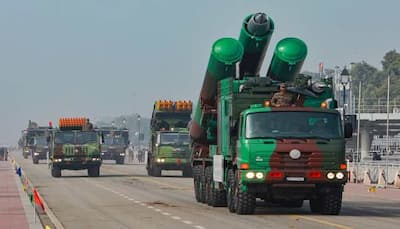New Delhi: Tensions between India and Pakistan eased since May 10 evening after the latter’s Director General of Military Operations dialed his Indian counterpart urging a ceasefire. No exchange of fire was reported, and both the Line of Control and the International Border remained largely peaceful since May 10 evening. During a morning press briefing, earlier that day, the Ministry of Defence stated that Pakistan had attempted to target Indian military infrastructure on the western front using drones, long-range weapons and fighter jets.
Addressing the press conference, Colonel Sofia Qureshi revealed that at 1:40 AM on May 10, Pakistan had attempted to strike an airbase in Punjab using a high-speed missile. It is, however, unclear as to which specific missile Pakistan used. Missiles are generally categorised based on type, launch method, range, warhead and guidance system. They are broadly classified as either cruise missiles or ballistic missiles.
What are the differences between cruise and ballistic missiles?
Defence experts explained that missiles classified as cruise missiles typically do not exceed speeds of Mach 5 (five times the speed of sound). Ballistic missiles are considered high-speed because they travel faster than the speed of sound. While the exact missile launched by Pakistan remains unknown, the experts suggested it was likely a ballistic missile, given its high velocity.
Hypersonic missiles travel at speeds up to ten times that of sound, and ballistic missiles also move much faster than the speed of sound. When one refers to high-speed missiles, he or she usually speaks of ballistic missiles. Pakistan’s missile arsenal is largely composed of ballistic missiles; whereas, India possesses a broader and more advanced range.
Along with other long-range missiles, Pakistan possesses a hypersonic missile called Fateh-II, with a range of up to 400 kilometers. The other long-rage missiles Pakistan have include Abdali (with a range of 200 to 300 kilometres) and Ghaznavi (which has a range of 300 to 350 kilometres).
On the other hand, India’s high-speed missile capabilities include a wide range of missile arsenal, including the Prithvi and Agni series, which gives it a strategic edge in terms of both range and variety.
Cruise missiles function differently from ballistic ones. They fly like aircraft and are capable of precision targeting over long distances. Designed to evade radar by flying at low altitudes, they are equipped with sophisticated navigation systems. Cruise missiles can be launched from land, air, sea or submarines, and some can strike targets over a thousand kilometre away.
India’s cruise missile arsenal includes the BrahMos and Nirbhay, both of which are highly advanced. Cruise missiles are also classified based on speed – subsonic missiles travel below the speed of sound, supersonic missiles travel at two to three times the speed of sound and hypersonic missiles travel at five times the speed of sound or more.
If elaboarted hypersonic missiles, they first ascend to altitudes around 100 kilometers, temporarily exiting the earth’s atmosphere before re-entering during their descent to strike the target. Due to their speed and trajectory, these missiles are extremely difficult to detect or intercept. Hypersonic missiles can carry both conventional and nuclear warheads.
In November 2024, India successfully tested a long-range hypersonic missile with a range of over 1,500 kilometres. This missile can be launched from air, sea or land platforms, giving India enhanced flexibility in deployment.
Defence experts said Pakistan, as of now, does not possess hypersonic missile capabilities.
Stay informed on all the , real-time updates, and follow all the important headlines in and on Zee News.








